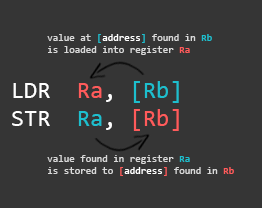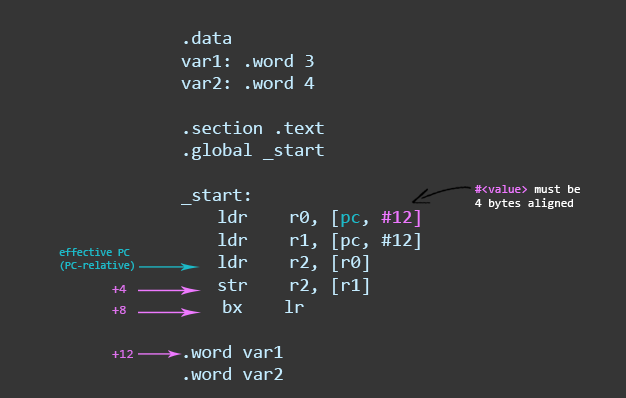ARM uses a load-store model for memory access which means that only load/store (LDR and STR) instructions can access memory. While on x86 most instructions are allowed to directly operate on data in memory, on ARM data must be moved from memory into registers before being operated on. This means that incrementing a 32-bit value at a particular memory address on ARM would require three types of instructions (load, increment, and store) to first load the value at a particular address into a register, increment it within the register, and store it back to the memory from the register.
To explain the fundamentals of Load and Store operations on ARM, we start with a basic example and continue with three basic offset forms with three different address modes for each offset form. For each example we will use the same piece of assembly code with a different LDR/STR offset form, to keep it simple. The best way to follow this part of the tutorial is to run the code examples in a debugger (GDB) on your lab environment.
- Offset form: Immediate value as the offset
- Addressing mode: Offset
- Addressing mode: Pre-indexed
- Addressing mode: Post-indexed
- Offset form: Register as the offset
- Addressing mode: Offset
- Addressing mode: Pre-indexed
- Addressing mode: Post-indexed
- Offset form: Scaled register as the offset
- Addressing mode: Offset
- Addressing mode: Pre-indexed
- Addressing mode: Post-indexed
First basic example
Generally, LDR is used to load something from memory into a register, and STR is used to store something from a register to a memory address.

LDR R2, [R0] @ [R0] - origin address is the value found in R0. STR R2, [R1] @ [R1] - destination address is the value found in R1.
LDR operation: loads the value at the address found in R0 to the destination register R2.
STR operation: stores the value found in R2 to the memory address found in R1.
This is how it would look like in a functional assembly program:
.data /* the .data section is dynamically created and its addresses cannot be easily predicted */
var1: .word 3 /* variable 1 in memory */
var2: .word 4 /* variable 2 in memory */
.text /* start of the text (code) section */
.global _start
_start:
ldr r0, adr_var1 @ load the memory address of var1 via label adr_var1 into R0
ldr r1, adr_var2 @ load the memory address of var2 via label adr_var2 into R1
ldr r2, [r0] @ load the value (0x03) at memory address found in R0 to register R2
str r2, [r1] @ store the value found in R2 (0x03) to the memory address found in R1
bkpt
adr_var1: .word var1 /* address to var1 stored here */
adr_var2: .word var2 /* address to var2 stored here */
At the bottom we have our Literal Pool (a memory area in the same code section to store constants, strings, or offsets that others can reference in a position-independent manner) where we store the memory addresses of var1 and var2 (defined in the data section at the top) using the labels adr_var1 and adr_var2. The first LDR loads the address of var1 into register R0. The second LDR does the same for var2 and loads it to R1. Then we load the value stored at the memory address found in R0 to R2, and store the value found in R2 to the memory address found in R1.
When we load something into a register, the brackets ([ ]) mean: the value found in the register between these brackets is a memory address we want to load something from.
When we store something to a memory location, the brackets ([ ]) mean: the value found in the register between these brackets is a memory address we want to store something to.
This sounds more complicated than it actually is, so here is a visual representation of what’s going on with the memory and the registers when executing the code above in a debugger:

Let’s look at the same code in a debugger.
gef> disassemble _start Dump of assembler code for function _start: 0x00008074 <+0>: ldr r0, [pc, #12] ; 0x8088 <adr_var1> 0x00008078 <+4>: ldr r1, [pc, #12] ; 0x808c <adr_var2> 0x0000807c <+8>: ldr r2, [r0] 0x00008080 <+12>: str r2, [r1] 0x00008084 <+16>: bx lr End of assembler dump.
The labels we specified with the first two LDR operations changed to [pc, #12]. This is called PC-relative addressing. Because we used labels, the compiler calculated the location of our values specified in the Literal Pool (PC+12). You can either calculate the location yourself using this exact approach, or you can use labels like we did previously. The only difference is that instead of using labels, you need to count the exact position of your value in the Literal Pool. In this case, it is 3 hops (4+4+4=12) away from the effective PC position. More about PC-relative addressing later in this chapter.
Side note: In case you forgot why the effective PC is located two instructions ahead of the current one, it is described in Part 2 [… During execution, PC stores the address of the current instruction plus 8 (two ARM instructions) in ARM state, and the current instruction plus 4 (two Thumb instructions) in Thumb state. This is different from x86 where PC always points to the next instruction to be executed…].

1. Offset form: Immediate value as the offset
STR Ra, [Rb, imm] LDR Ra, [Rc, imm]
Here we use an immediate (integer) as an offset. This value is added or subtracted from the base register (R1 in the example below) to access data at an offset known at compile time.
.data
var1: .word 3
var2: .word 4
.text
.global _start
_start:
ldr r0, adr_var1 @ load the memory address of var1 via label adr_var1 into R0
ldr r1, adr_var2 @ load the memory address of var2 via label adr_var2 into R1
ldr r2, [r0] @ load the value (0x03) at memory address found in R0 to register R2
str r2, [r1, #2] @ address mode: offset. Store the value found in R2 (0x03) to the memory address found in R1 plus 2. Base register (R1) unmodified.
str r2, [r1, #4]! @ address mode: pre-indexed. Store the value found in R2 (0x03) to the memory address found in R1 plus 4. Base register (R1) modified: R1 = R1+4
ldr r3, [r1], #4 @ address mode: post-indexed. Load the value at memory address found in R1 to register R3. Base register (R1) modified: R1 = R1+4
bkpt
adr_var1: .word var1
adr_var2: .word var2
Let’s call this program ldr.s, compile it and run it in GDB to see what happens.
$ as ldr.s -o ldr.o $ ld ldr.o -o ldr $ gdb ldr
In GDB (with gef) we set a break point at _start and run the program.
gef> break _start gef> run ... gef> nexti 3 /* to run the next 3 instructions */
The registers on my system are now filled with the following values (keep in mind that these addresses might be different on your system):
$r0 : 0x00010098 -> 0x00000003 $r1 : 0x0001009c -> 0x00000004 $r2 : 0x00000003 $r3 : 0x00000000 $r4 : 0x00000000 $r5 : 0x00000000 $r6 : 0x00000000 $r7 : 0x00000000 $r8 : 0x00000000 $r9 : 0x00000000 $r10 : 0x00000000 $r11 : 0x00000000 $r12 : 0x00000000 $sp : 0xbefff7e0 -> 0x00000001 $lr : 0x00000000 $pc : 0x00010080 -> <_start+12> str r2, [r1] $cpsr : 0x00000010
The next instruction that will be executed a STR operation with the offset address mode. It will store the value from R2 (0x00000003) to the memory address specified in R1 (0x0001009c) + the offset (#2) = 0x1009e.
gef> nexti gef> x/w 0x1009e 0x1009e <var2+2>: 0x3
The next STR operation uses the pre-indexed address mode. You can recognize this mode by the exclamation mark (!). The only difference is that the base register will be updated with the final memory address in which the value of R2 will be stored. This means, we store the value found in R2 (0x3) to the memory address specified in R1 (0x1009c) + the offset (#4) = 0x100A0, and update R1 with this exact address.
gef> nexti gef> x/w 0x100A0 0x100a0: 0x3 gef> info register r1 r1 0x100a0 65696
The last LDR operation uses the post-indexed address mode. This means that the base register (R1) is used as the final address, then updated with the offset calculated with R1+4. In other words, it takes the value found in R1 (not R1+4), which is 0x100A0 and loads it into R3, then updates R1 to R1 (0x100A0) + offset (#4) = 0x100a4.
gef> info register r1 r1 0x100a4 65700 gef> info register r3 r3 0x3 3
Here is an abstract illustration of what’s happening:
2. Offset form: Register as the offset.
STR Ra, [Rb, Rc] LDR Ra, [Rb, Rc]
This offset form uses a register as an offset. An example usage of this offset form is when your code wants to access an array where the index is computed at run-time.
.data
var1: .word 3
var2: .word 4
.text
.global _start
_start:
ldr r0, adr_var1 @ load the memory address of var1 via label adr_var1 to R0
ldr r1, adr_var2 @ load the memory address of var2 via label adr_var2 to R1
ldr r2, [r0] @ load the value (0x03) at memory address found in R0 to R2
str r2, [r1, r2] @ address mode: offset. Store the value found in R2 (0x03) to the memory address found in R1 with the offset R2 (0x03). Base register unmodified.
str r2, [r1, r2]! @ address mode: pre-indexed. Store value found in R2 (0x03) to the memory address found in R1 with the offset R2 (0x03). Base register modified: R1 = R1+R2.
ldr r3, [r1], r2 @ address mode: post-indexed. Load value at memory address found in R1 to register R3. Then modify base register: R1 = R1+R2.
bx lr
adr_var1: .word var1
adr_var2: .word var2
After executing the first STR operation with the offset address mode, the value of R2 (0x00000003) will be stored at memory address 0x0001009c + 0x00000003 = 0x0001009F.
gef> x/w 0x0001009F
0x1009f <var2+3>: 0x00000003
The second STR operation with the pre-indexed address mode will do the same, with the difference that it will update the base register (R1) with the calculated memory address (R1+R2).
gef> info register r1
r1 0x1009f 65695
The last LDR operation uses the post-indexed address mode and loads the value at the memory address found in R1 into the register R2, then updates the base register R1 (R1+R2 = 0x1009f + 0x3 = 0x100a2).
gef> info register r1 r1 0x100a2 65698 gef> info register r3 r3 0x3 3
3. Offset form: Scaled register as the offset
LDR Ra, [Rb, Rc, <shifter>] STR Ra, [Rb, Rc, <shifter>]
The third offset form has a scaled register as the offset. In this case, Rb is the base register and Rc is an immediate offset (or a register containing an immediate value) left/right shifted (<shifter>) to scale the immediate. This means that the barrel shifter is used to scale the offset. An example usage of this offset form would be for loops to iterate over an array. Here is a simple example you can run in GDB:
.data
var1: .word 3
var2: .word 4
.text
.global _start
_start:
ldr r0, adr_var1 @ load the memory address of var1 via label adr_var1 to R0
ldr r1, adr_var2 @ load the memory address of var2 via label adr_var2 to R1
ldr r2, [r0] @ load the value (0x03) at memory address found in R0 to R2
str r2, [r1, r2, LSL#2] @ address mode: offset. Store the value found in R2 (0x03) to the memory address found in R1 with the offset R2 left-shifted by 2. Base register (R1) unmodified.
str r2, [r1, r2, LSL#2]! @ address mode: pre-indexed. Store the value found in R2 (0x03) to the memory address found in R1 with the offset R2 left-shifted by 2. Base register modified: R1 = R1 + R2<<2
ldr r3, [r1], r2, LSL#2 @ address mode: post-indexed. Load value at memory address found in R1 to the register R3. Then modifiy base register: R1 = R1 + R2<<2
bkpt
adr_var1: .word var1
adr_var2: .word var2
The first STR operation uses the offset address mode and stores the value found in R2 at the memory location calculated from [r1, r2, LSL#2], which means that it takes the value in R1 as a base (in this case, R1 contains the memory address of var2), then it takes the value in R2 (0x3), and shifts it left by 2. The picture below is an attempt to visualize how the memory location is calculated with [r1, r2, LSL#2].

The second STR operation uses the pre-indexed address mode. This means, it performs the same action as the previous operation, with the difference that it updates the base register R1 with the calculated memory address afterwards. In other words, it will first store the value found at the memory address R1 (0x1009c) + the offset left shifted by #2 (0x03 LSL#2 = 0xC) = 0x100a8, and update R1 with 0x100a8.
gef> info register r1
r1 0x100a8 65704
The last LDR operation uses the post-indexed address mode. This means, it loads the value at the memory address found in R1 (0x100a8) into register R3, then updates the base register R1 with the value calculated with r2, LSL#2. In other words, R1 gets updated with the value R1 (0x100a8) + the offset R2 (0x3) left shifted by #2 (0xC) = 0x100b4.
gef> info register r1
r1 0x100b4 65716




